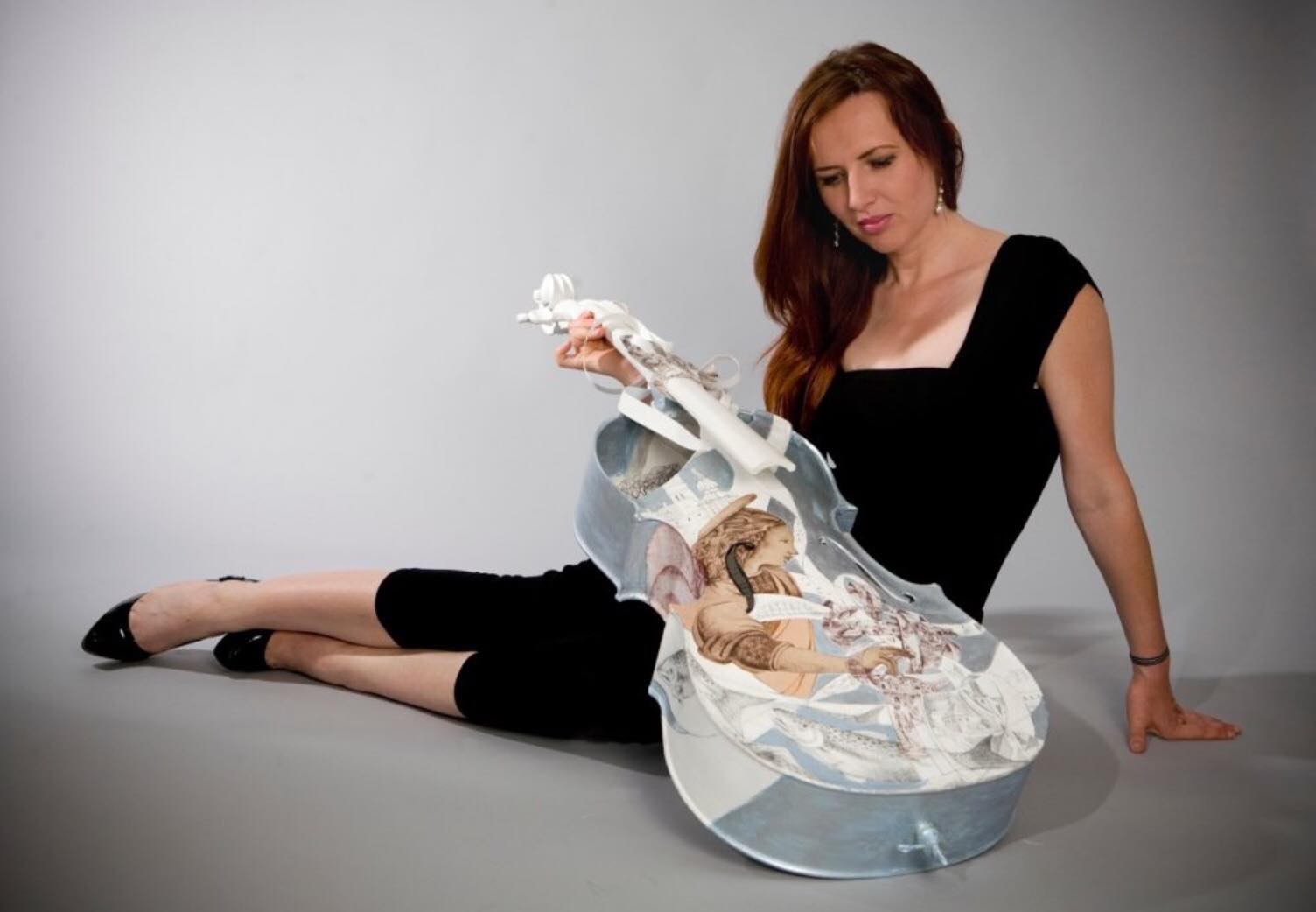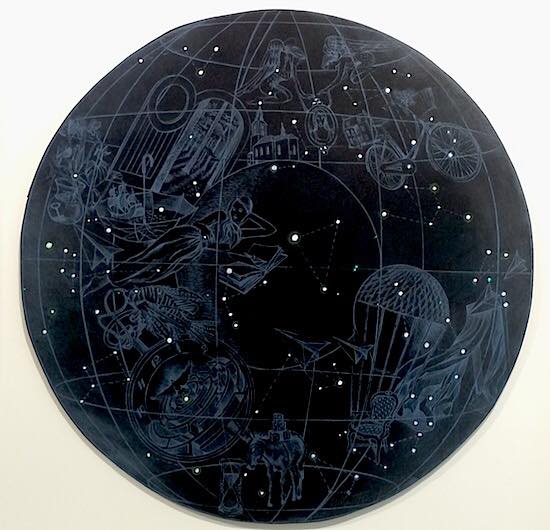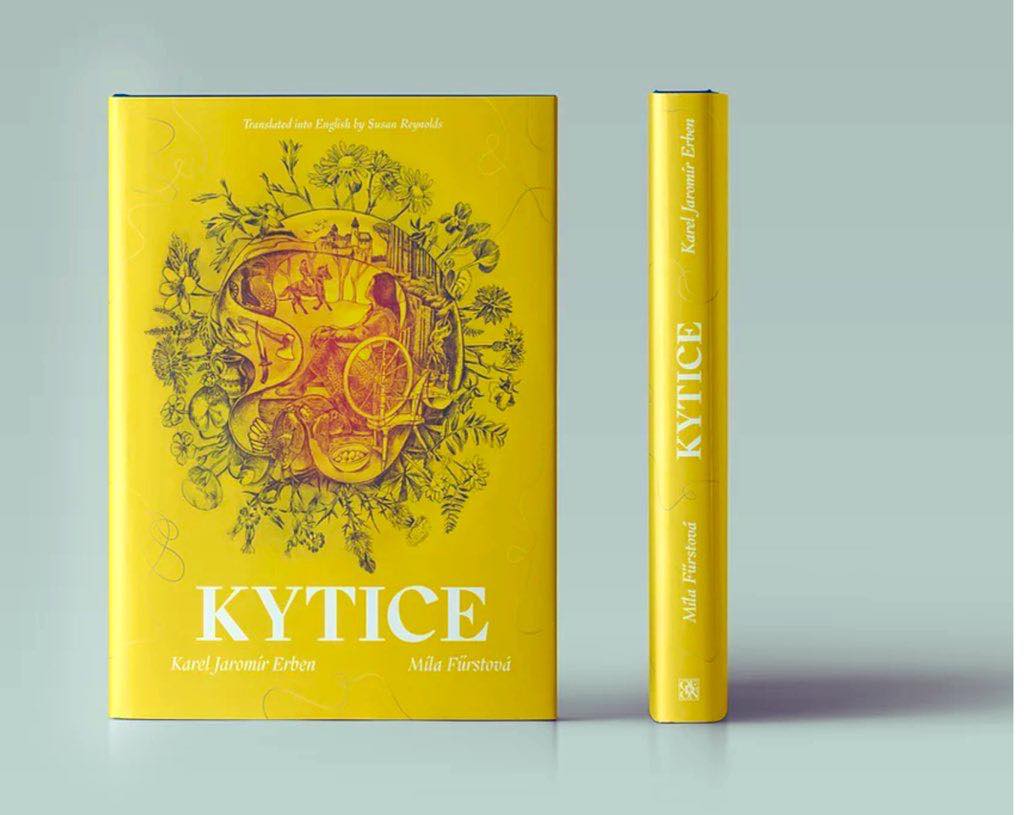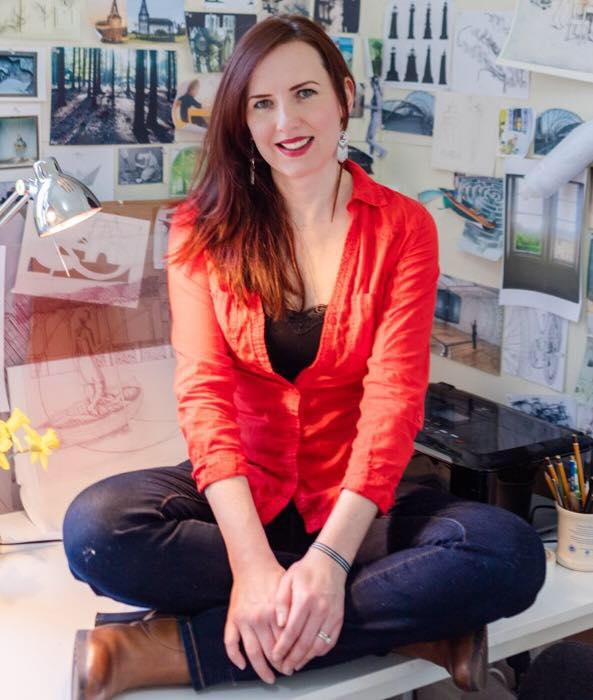The young Czech sort of failed to succeed in her homeland, left for England, and it was only there that she won recognition by collaborating with supergroup Coldplay. She made the artwork for their album Ghost Stories, which opened the door to the world for her.
How did you meet Coldplay? Had you known about them beforehand, had you perceived their music?
Coldplay are much celebrated here in the UK, and so I’d encountered their music relatively often on the radio. But I’d never been to their concert before I started collaborating with them. To my surprise I found out that Coldplay had already known my art a few years before we met, and they had even bought a few items from my English gallery Eames Fine Art without my knowing about it.

What were they like and how was the collaboration taking place, how long? There was allegedly a funny situation when Chris was worried whether you’d cope with the work while being in the family way?
Our collaboration started at a time when I had my five-month-old son. I was very busy then but, at the same time, Coldplay actually lent me a hand and dragged me out of dealing with nappies back to art for at least several hours a day.
Our collaboration lasted nearly two years, and I became pregnant in that period again. When I came to a meeting with Coldplay and Chris Martin saw my growing belly, he said, “I didn’t know that you are pregnant”. It seemed to me that he was a bit worried whether in this condition I’d cope with the pressure that was on me. I assured him that everything would be OK.
Was it your idea to put the wings on the cover?
Given that I hadn’t accepted any commissions until then, we found ourselves in relatively challenging territory. I’m used to doing my art based on my own deep experiences, and now I was to take over something from outside. The Ghost Stories album resonated a lot in me, but it still took me a few months to find the right way. Coldplay turned out to be true artists who profoundly understand the creative process and they decided to help me by experiencing my art in depth themselves. They covered all the walls of their recording studio with my graphics and, after they lived with them for several weeks, it was Chris Martin himself who came up with the idea with the wings on one of my graphics.

Are you still in touch with Chris or anyone from Coldplay today?
Yes, I’m still in touch with Coldplay. They know what I’m creating and, for example, they were the first to get the English version of Kytice (also known as A Bouquet of Czech Folktales) by K. J. Erben illustrated by me, which came out three months ago.
How important was the collaboration with Coldplay to you? I suppose that it was very important. What doors did it open for you?
It was one of the most important collaborations for me ever. Working with Coldplay was absolutely unforgettable both from a human and artistic point of view. They’re utterly exceptional, talented musicians and, at the same time, they’ve got a huge amount of humanity and humility. I’ve learned a lot from them, for example, the fact what amazing things may result from true creative harmony. Before meeting Coldplay I had always only been creatively dependent on myself.
Concerning the opening of doors I think that, paradoxically, Coldplay opened the door to Czechia for me. As an eighteen-year-old student I wasn’t admitted in Prague either to the Academy of Fine Arts or to the Academy of Arts, Architecture and Design, so I left for England with my confidence hurt, where after some time I was admitted to study at one of the world’s most prestigious schools of fine arts, The Royal College of Art. I was building my artistic career in England and I had neither the courage or the impulse to professionally return to Czechia. But following my collaboration with Coldplay I was discovered by the Czech press, and today I’m grateful for the fact that my work resonates in Czechia and the number of my Czech collectors is rising very rapidly.

You’ve also drawn the cover for singer Sasha Siem and dust jackets for the book series Mortal Instruments by Cassandra Clare. Tell us a bit more about that…
After the collaboration with Coldplay, I was swamped with new offers for album covers from various global bands. However, following the two-year commission I wanted to have time for my own work. I was a relatively fresh mother of two children and I intended to produce a collection of works about motherhood. At the time when I finished this series “Motherhood”, an offer came from Sasha Siem, which I found very interesting both musically and intellectually. And then a commission for illustrating six book jackets of “Mortal Instruments” came from the US, and as I had always wanted to at least try illustrating a book I accepted the offer.
It is no secret that you were not initially admitted to art school in Prague, and so you applied for a scholarship in English and were given it. And then everything got under way fairly well, didn’t it? Was plenty of work, sometimes even chance behind it? How was it?
When I look back at the time 20 years ago, I must say that I’m working really very intensely. I think that no other way is possible in art, anyway. If work is to be good, it can’t be skimped, one has not only to invest lots of hours in it, but they must also devote themselves to it. If a work has no soul, people will find out. With every new work, the artist needs to try to grow and go beyond what they’ve done previously. And when one does all of this with humility and conscientiousness, at the moment when some suitable chance crops up, they are able to turn it into an opportunity.
What are you working on now?
I spent most of the year 2020 by illustrating Erben’s Kytice. The stimulus for this big challenge came from London from British publisher Jantar, which approached me to illustrate the English translation of Kytice for the international market. Initially, I was hesitant about the offer as the ballads in Kytice are actually horror ones, but when Covid-19 then broke out and all of my air tickets to Czechia, where I often return, were cancelled, I was glad that I could at least be in the Czech setting of Erben’s work every day as part of my work, and I think that I interpreted the horror itself in a way that is in line with my other creations.
Kytice also came out with my illustrations in the Czech Republic just before Christmas and, to my huge surprise, it sold out immediately and a second edition went to press in January. A third edition already began to be printed in March.

How are you actually getting over the Covid-19 period? Are you closed at home a lot? And what do you think of this period? What has it taken away from us and, maybe, given us?
When Covid-19 hit Europe for the first time, I was confident that we’d fight off the virus within a few weeks and then everything would be as before. Today, one year after lockdown started here in England, I still can’t believe the fact that neither now can we talk about Covid-19 in the past tense. Yes, we were locked at home with our two small schoolchildren. We’ve tried and we keep trying to handle the whole situation in the best possible way and to be happy about simple things, but it’s a big lesson for us and we learn every day.
On top of that, I strongly feel the physical detachment from Czechia, where my parents and brother with his family are. All of us are extremely homesick.
Which of your exhibitions do you value most? You exhibit in the UK, in the Czech Republic as well as in Hong Kong, in Chicago…?
I’m very lucky to be exhibiting all over the world. However, the longer I do my job the more I regard one type of exhibition as the most important. Namely when those who buy my art exhibit my works at home and live with them every day. Frankly, it’s an immense gift for me that my works become part of the most important space: home. My collectors often write to me what my works mean to them, what they see in them, how their children react to them. I’m always very delighted about that and I feel that the dream I’ve always had is coming true through this... To connect with people and enrich them through my art.

Have you got any big dream as to what and where you would like to do something?
My dream is to bring something positive and beautiful to people’s lives through my art… To do something that’s meaningful. I strive to work on each of my works in this spirit and also be open to potential offers that would help me materialise that as much as possible.
Do you often return to the Czech Republic, and what do you find appealing about Czechia? For example, we have got skilful artists, don’t we?
I return to the Czech Republic as often as possible. I think I’ll always remain Czech in my heart, although I’ve now been living in England longer than in the Czech Republic.
To tell you what I like about the Czech Republic, I’d need hundreds of pages. This very morning I wrote something about Czechia to the small son of my British friends because he’s learning about it at school. I described in brief to him that the Czechs are people who love art and nature, I told him that when he’d be walking through the streets of Prague one day, he should look up to see not only the most exquisite architecture with a playful sense of detail but also lots of stone angels waving to him from the facades of houses or bridges. I depicted to him how we Czechs like to go mushrooming, early in the morning when the wood is fresh, the moss is fragrant and full of dew, and there’s light among the trees like in a cathedral. And I sent him Vltava by Bedřich Smetana and advised him to close his eyes when listening to it and to feel as a small glittering spring gushes out of the earth, how tributaries eventually join it, how it changes into a river, how people dance on its banks and how it flows as a majestic watercourse through Prague.

You hail from Pelhřimov, from the Bohemian-Moravian Highlands, an interesting region. Have you been there recently?
I was born in Pelhřimov and then lived in Hořepník, where my mum comes from, until I was two. We then moved to Hradec Králové, from where my dad comes. I spent my childhood there, even though we would come back to Hořepník to stay with our grandma every summer and on every possible weekend. So, I have a strong relationship with both Hořepník and Hradec Králové. I managed to get to the both places with our children in the summer, but our planned Christmas and Easter trips there were cancelled due to Covid-19.
What places that you like in our country would you invite foreign visitors to?
As I spent the most beautiful moments of my childhood in the Bohemian-Moravian Highlands, I’d definitely invite my foreign friends to go there. Although I can say the same, for example, about Hradec Králové. It’s an architecturally exquisite as well as very relaxed city. I also like, for example, Telč and Šumava mountains a lot. I think that the Czech Republic is simply worth exploring.

Coldplay are much celebrated here in the UK, and so I’d encountered their music relatively often on the radio. But I’d never been to their concert before I started collaborating with them. To my surprise I found out that Coldplay had already known my art a few years before we met, and they had even bought a few items from my English gallery Eames Fine Art without my knowing about it.

What were they like and how was the collaboration taking place, how long? There was allegedly a funny situation when Chris was worried whether you’d cope with the work while being in the family way?
Our collaboration started at a time when I had my five-month-old son. I was very busy then but, at the same time, Coldplay actually lent me a hand and dragged me out of dealing with nappies back to art for at least several hours a day.
Our collaboration lasted nearly two years, and I became pregnant in that period again. When I came to a meeting with Coldplay and Chris Martin saw my growing belly, he said, “I didn’t know that you are pregnant”. It seemed to me that he was a bit worried whether in this condition I’d cope with the pressure that was on me. I assured him that everything would be OK.
Was it your idea to put the wings on the cover?
Given that I hadn’t accepted any commissions until then, we found ourselves in relatively challenging territory. I’m used to doing my art based on my own deep experiences, and now I was to take over something from outside. The Ghost Stories album resonated a lot in me, but it still took me a few months to find the right way. Coldplay turned out to be true artists who profoundly understand the creative process and they decided to help me by experiencing my art in depth themselves. They covered all the walls of their recording studio with my graphics and, after they lived with them for several weeks, it was Chris Martin himself who came up with the idea with the wings on one of my graphics.

Are you still in touch with Chris or anyone from Coldplay today?
Yes, I’m still in touch with Coldplay. They know what I’m creating and, for example, they were the first to get the English version of Kytice (also known as A Bouquet of Czech Folktales) by K. J. Erben illustrated by me, which came out three months ago.
How important was the collaboration with Coldplay to you? I suppose that it was very important. What doors did it open for you?
It was one of the most important collaborations for me ever. Working with Coldplay was absolutely unforgettable both from a human and artistic point of view. They’re utterly exceptional, talented musicians and, at the same time, they’ve got a huge amount of humanity and humility. I’ve learned a lot from them, for example, the fact what amazing things may result from true creative harmony. Before meeting Coldplay I had always only been creatively dependent on myself.
Concerning the opening of doors I think that, paradoxically, Coldplay opened the door to Czechia for me. As an eighteen-year-old student I wasn’t admitted in Prague either to the Academy of Fine Arts or to the Academy of Arts, Architecture and Design, so I left for England with my confidence hurt, where after some time I was admitted to study at one of the world’s most prestigious schools of fine arts, The Royal College of Art. I was building my artistic career in England and I had neither the courage or the impulse to professionally return to Czechia. But following my collaboration with Coldplay I was discovered by the Czech press, and today I’m grateful for the fact that my work resonates in Czechia and the number of my Czech collectors is rising very rapidly.

You’ve also drawn the cover for singer Sasha Siem and dust jackets for the book series Mortal Instruments by Cassandra Clare. Tell us a bit more about that…
After the collaboration with Coldplay, I was swamped with new offers for album covers from various global bands. However, following the two-year commission I wanted to have time for my own work. I was a relatively fresh mother of two children and I intended to produce a collection of works about motherhood. At the time when I finished this series “Motherhood”, an offer came from Sasha Siem, which I found very interesting both musically and intellectually. And then a commission for illustrating six book jackets of “Mortal Instruments” came from the US, and as I had always wanted to at least try illustrating a book I accepted the offer.
It is no secret that you were not initially admitted to art school in Prague, and so you applied for a scholarship in English and were given it. And then everything got under way fairly well, didn’t it? Was plenty of work, sometimes even chance behind it? How was it?
When I look back at the time 20 years ago, I must say that I’m working really very intensely. I think that no other way is possible in art, anyway. If work is to be good, it can’t be skimped, one has not only to invest lots of hours in it, but they must also devote themselves to it. If a work has no soul, people will find out. With every new work, the artist needs to try to grow and go beyond what they’ve done previously. And when one does all of this with humility and conscientiousness, at the moment when some suitable chance crops up, they are able to turn it into an opportunity.
What are you working on now?
I spent most of the year 2020 by illustrating Erben’s Kytice. The stimulus for this big challenge came from London from British publisher Jantar, which approached me to illustrate the English translation of Kytice for the international market. Initially, I was hesitant about the offer as the ballads in Kytice are actually horror ones, but when Covid-19 then broke out and all of my air tickets to Czechia, where I often return, were cancelled, I was glad that I could at least be in the Czech setting of Erben’s work every day as part of my work, and I think that I interpreted the horror itself in a way that is in line with my other creations.
Kytice also came out with my illustrations in the Czech Republic just before Christmas and, to my huge surprise, it sold out immediately and a second edition went to press in January. A third edition already began to be printed in March.

How are you actually getting over the Covid-19 period? Are you closed at home a lot? And what do you think of this period? What has it taken away from us and, maybe, given us?
When Covid-19 hit Europe for the first time, I was confident that we’d fight off the virus within a few weeks and then everything would be as before. Today, one year after lockdown started here in England, I still can’t believe the fact that neither now can we talk about Covid-19 in the past tense. Yes, we were locked at home with our two small schoolchildren. We’ve tried and we keep trying to handle the whole situation in the best possible way and to be happy about simple things, but it’s a big lesson for us and we learn every day.
On top of that, I strongly feel the physical detachment from Czechia, where my parents and brother with his family are. All of us are extremely homesick.
Which of your exhibitions do you value most? You exhibit in the UK, in the Czech Republic as well as in Hong Kong, in Chicago…?
I’m very lucky to be exhibiting all over the world. However, the longer I do my job the more I regard one type of exhibition as the most important. Namely when those who buy my art exhibit my works at home and live with them every day. Frankly, it’s an immense gift for me that my works become part of the most important space: home. My collectors often write to me what my works mean to them, what they see in them, how their children react to them. I’m always very delighted about that and I feel that the dream I’ve always had is coming true through this... To connect with people and enrich them through my art.

Have you got any big dream as to what and where you would like to do something?
My dream is to bring something positive and beautiful to people’s lives through my art… To do something that’s meaningful. I strive to work on each of my works in this spirit and also be open to potential offers that would help me materialise that as much as possible.
Do you often return to the Czech Republic, and what do you find appealing about Czechia? For example, we have got skilful artists, don’t we?
I return to the Czech Republic as often as possible. I think I’ll always remain Czech in my heart, although I’ve now been living in England longer than in the Czech Republic.
To tell you what I like about the Czech Republic, I’d need hundreds of pages. This very morning I wrote something about Czechia to the small son of my British friends because he’s learning about it at school. I described in brief to him that the Czechs are people who love art and nature, I told him that when he’d be walking through the streets of Prague one day, he should look up to see not only the most exquisite architecture with a playful sense of detail but also lots of stone angels waving to him from the facades of houses or bridges. I depicted to him how we Czechs like to go mushrooming, early in the morning when the wood is fresh, the moss is fragrant and full of dew, and there’s light among the trees like in a cathedral. And I sent him Vltava by Bedřich Smetana and advised him to close his eyes when listening to it and to feel as a small glittering spring gushes out of the earth, how tributaries eventually join it, how it changes into a river, how people dance on its banks and how it flows as a majestic watercourse through Prague.

You hail from Pelhřimov, from the Bohemian-Moravian Highlands, an interesting region. Have you been there recently?
I was born in Pelhřimov and then lived in Hořepník, where my mum comes from, until I was two. We then moved to Hradec Králové, from where my dad comes. I spent my childhood there, even though we would come back to Hořepník to stay with our grandma every summer and on every possible weekend. So, I have a strong relationship with both Hořepník and Hradec Králové. I managed to get to the both places with our children in the summer, but our planned Christmas and Easter trips there were cancelled due to Covid-19.
What places that you like in our country would you invite foreign visitors to?
As I spent the most beautiful moments of my childhood in the Bohemian-Moravian Highlands, I’d definitely invite my foreign friends to go there. Although I can say the same, for example, about Hradec Králové. It’s an architecturally exquisite as well as very relaxed city. I also like, for example, Telč and Šumava mountains a lot. I think that the Czech Republic is simply worth exploring.










-(1).jpg?width=1920&height=1204&ext=.jpg)
